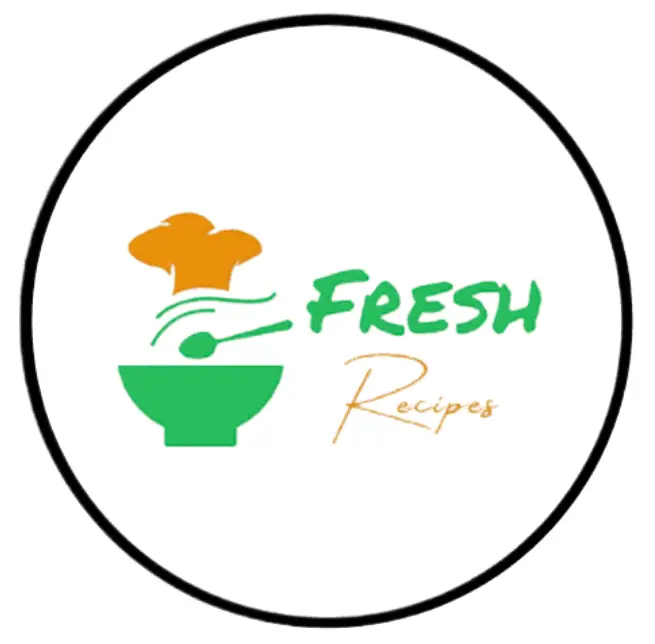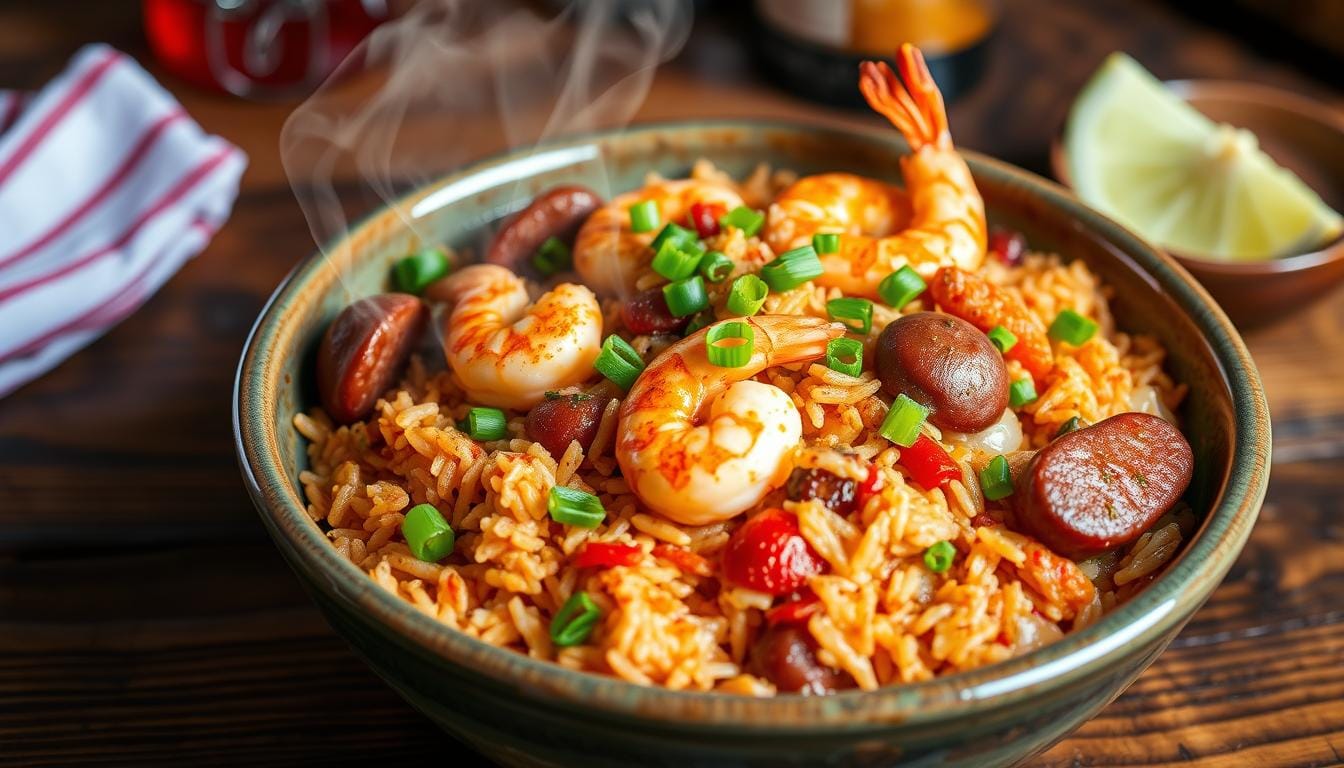Jambalaya: The Spicy Cajun Dish You Need to Try
Five years ago, my culinary journey changed when I first tried authentic Louisiana Jambalaya. The first time I tasted those aromatic Cajun spices, I knew it was special. It wasn’t just a recipe; it was a cultural experience.
Jambalaya is more than a meal; it’s a celebration of Louisiana’s rich food heritage. This dish combines rice, proteins, and spices in one pot. It tells a story of cultural fusion and cooking traditions passed down through generations.
In New Orleans’ streets and Southern home kitchens, Jambalaya is a favorite. It’s loved for its complex flavors and easy recipe. It’s a true culinary masterpiece that you’ll want to learn to make.
Table of Contents
Key Takeaways
- Jambalaya represents authentic Louisiana cuisine
- The dish combines multiple cultural influences
- Cajun spices create a unique flavor profile
- It’s a versatile one-pot meal perfect for gatherings
- Understanding the recipe’s history enhances appreciation
Understanding the Rich History of Jambalaya
This dish is a tasty journey through Louisiana’s food culture. It’s a mix of French, Spanish, African, and Native American traditions. These influences have shaped creole cuisine for centuries.
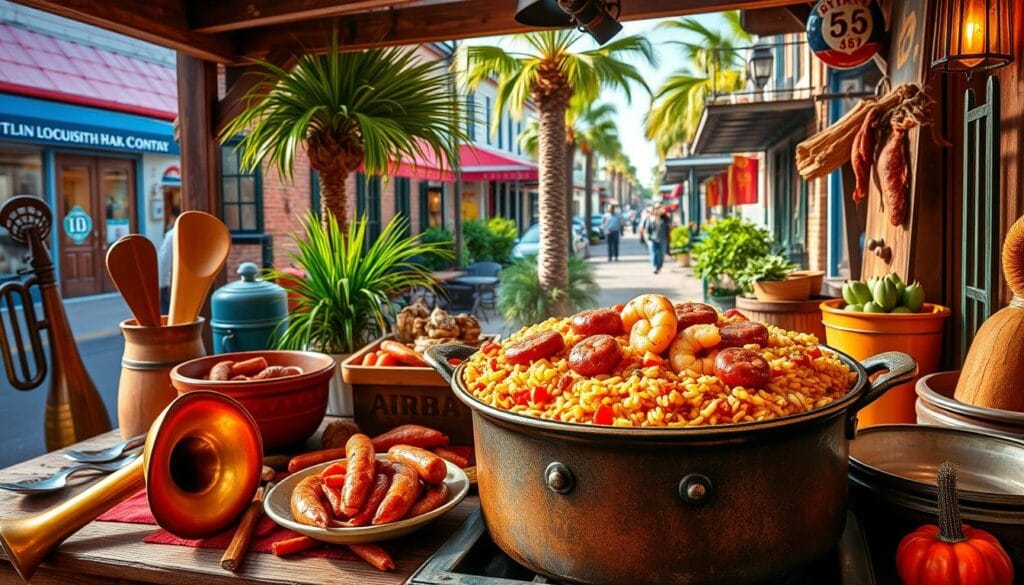
The story of jambalaya starts with Louisiana’s diverse heritage. It began with settlers and enslaved people. About 60% of enslaved people came from Senegambia, a rice-growing area.
Cultural Roots and Influences
Jambalaya comes from a mix of cooking traditions. Key influences include:
- Spanish paella techniques
- French cooking methods
- West African rice traditions
- Native American ingredient selections
Etymology and Evolution
The name “Jambalaya” shows its mixed roots. It combines French jambon (ham) with West African aya (rice). The word first appeared in a poem in 1837.
Traditional and Modern Interpretations
In Louisiana, jamb-alaya has two main types: Creole and Cajun. Creole-jambalaya is red because of tomatoes. Cajun jambalaya is smokier, without tomatoes.
“Jambalaya is more than a dish—it’s a celebration of Louisiana’s diverse cultural heritage.”
Today, This Recipe keeps changing, showing the spirit of creole cuisine. Every region and family adds its own twist. This keeps it a beloved part of American food.
The Essential Ingredients for Authentic Jambalaya
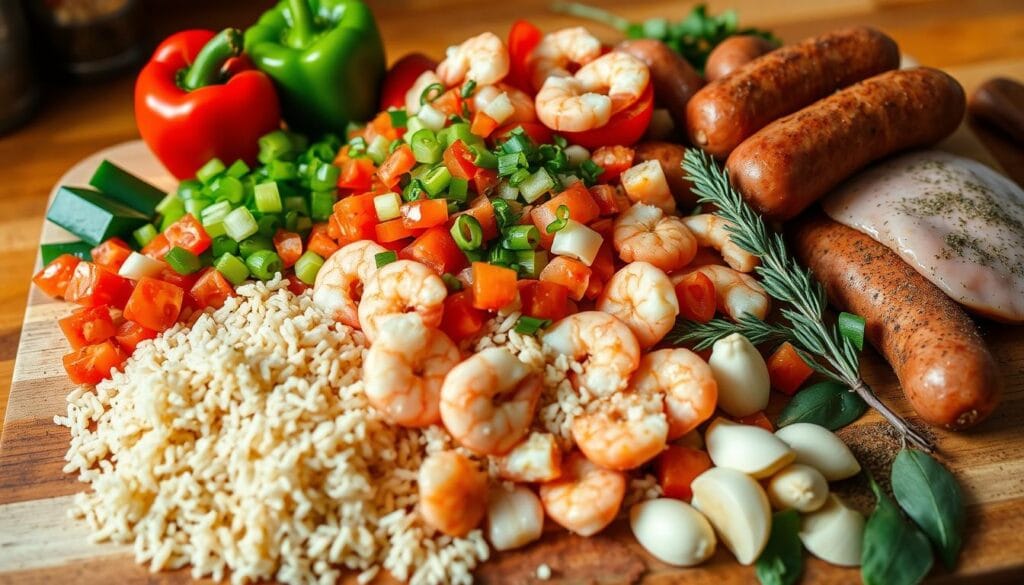
To make a real jamb-alaya, you need the right mix of ingredients. This mix brings the dish to life. It starts with proteins and vegetables that give it a unique taste.
The base of your jamb-alaya is the proteins. Andouille sausage is key, adding a smoky and spicy flavor. This Cajun sausage makes the dish truly special.
- Proteins that define jamb-alaya:
- Andouille sausage (10 ounces)
- Chicken (1 pound boneless, skinless)
- Seafood, especially shrimp (1 pound)
The vegetable trio is also vital. Known as the Cajun holy trinity, they form the flavor base. This makes jambalaya truly special:
- Vegetable essentials:
- 1 onion
- 1 green bell pepper
- 1 red bell pepper
- 2 celery stalks
“In Louisiana, jamb-alaya is more than a meal – it’s a celebration of flavor and culture.”
Rice is the canvas for these ingredients. Use long-grain white rice (1.5 cups uncooked) for the best flavor and texture. The seafood and sausage create a taste symphony.
| Ingredient Category | Quantity |
|---|---|
| Andouille Sausage | 10 ounces |
| Chicken | 1 pound |
| Seafood (Shrimp) | 1 pound |
| Uncooked Rice | 1.5 cups |
The secret to great jamb-alaya is balancing ingredients with spices and cooking. Your culinary adventure is about to start!
The Cajun Holy Trinity: Foundation of Flavor
In Cajun cooking, three simple vegetables are key. They make every one-pot meal taste amazing. Onions, bell peppers, and celery turn basic ingredients into something special.
Unveiling the Perfect Vegetable Ratio
Chef Paul Prudhomme made this combo famous in the late 1970s. He found the right mix for true Cajun flavors. Here’s what it is:
- 3 parts onions
- 2 parts celery
- 1 part bell pepper
Building Layers of Traditional Flavor
Sautéing these veggies together makes a strong, aromatic base. It’s perfect for dishes like jamb-alaya. The onion’s sweetness, celery’s slight bitterness, and bell pepper’s freshness mix for a unique Cajun taste.
Fresh Ingredients Matter
Choosing the right veggies is crucial. Pick fresh, vibrant ones for the best taste. Pro tip: Local, seasonal produce adds the most flavor to your meals.
“In Cajun cooking, the holy trinity is not just ingredients—it’s a culinary tradition passed through generations.” – Louisiana Culinary Experts
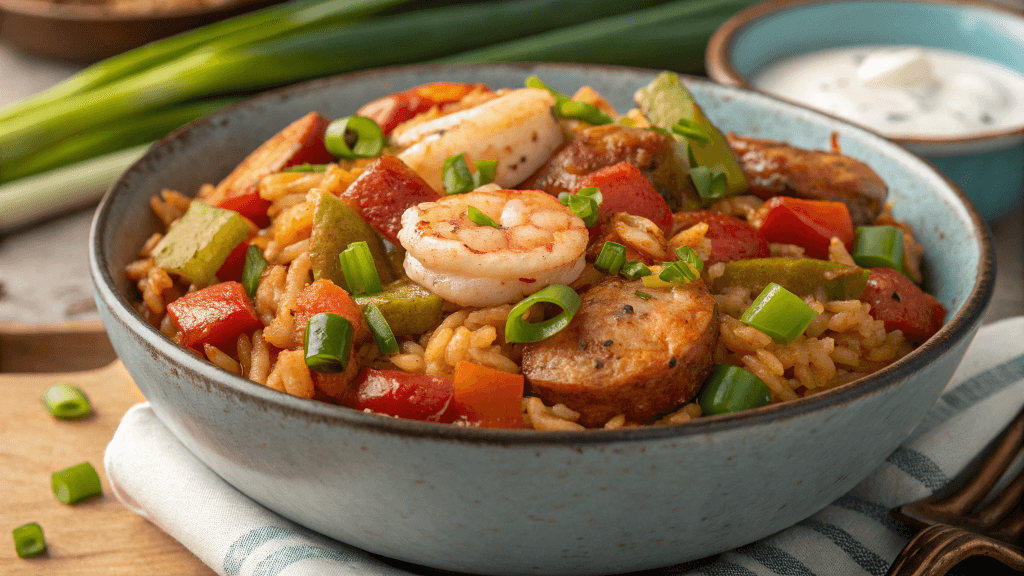
Choosing the Right Proteins for Your Jambalaya
Making the perfect jamb-alaya begins with picking the right proteins. These proteins add real flavor and texture. Traditional recipes mix proteins for a rich taste.
For Creole rice dish, mix proteins that work well together. The top mix includes:
- Andouille sausage – a spicy smoked sausage that adds incredible flavor
- Shrimp – providing a delicate seafood element
- Chicken – offering a tender, mild protein base
Choosing the right proteins changes your jamb-alaya’s taste. Andouille sausage adds a smoky, spicy flavor. Paired with shrimp, it makes a flavor mix that feels like Louisiana.
“The secret to great jambalaya is balancing your proteins with bold, authentic seasonings.” – Cajun Cooking Tradition
Protein Nutritional Breakdown
| Protein | Quantity | Calories | Protein Content |
|---|---|---|---|
| Chicken | 1 pound | 165 per cup | 31g per cup |
| Andouille Sausage | ½ pound | 220 per cup | 14g per cup |
| Shrimp | 10 large shrimp | 84 per cup | 20g per cup |
Pro tip: For real Cajun taste, use both shrimp and andouille sausage. They’re nutritious and true to Cajun cooking.
Mastering the Rice Cooking Technique
Rice is the heart of any great Creole rice dish, making it go from ordinary to extraordinary. Learning how to prepare rice can make your dish go from good to phenomenal.
Selecting the Perfect Rice Type
Long-grain white rice is the top choice for traditional Creole rice dish. It absorbs flavors well and keeps a nice texture, perfect for this Cajun classic.
- Choose long-grain white rice for authentic flavor
- Parboiled rice offers a fluffy alternative
- Avoid short-grain or sticky rice varieties
Avoiding Common Rice Cooking Mistakes
Getting the perfect rice texture is all about precision. Many struggle with mushy or undercooked rice. But with a few tips, you can master it.
| Mistake | Solution |
|---|---|
| Excess water | Use precise water-to-rice ratio (2.5 cups water per cup of rice) |
| Stirring too much | Minimize stirring to prevent starch release |
| Incorrect heat | Maintain medium-low heat during cooking |
Achieving the Ideal Texture
Technique is everything when cooking rice for Creole rice dish. You want grains that are tender but not mushy, with each kernel distinct and flavorful.
“The secret to perfect Creole rice dish is patience and precision” – Cajun Cooking Tradition
Pro tip: Rinse your rice for 1-2 minutes under cold water to remove excess starch. This simple step can dramatically improve your rice dish’s texture and prevent clumping.
Cajun vs. Creole Jambalaya: Understanding the Difference
In Louisiana, you’ll find a big difference between Cajun and Creole rice dish. Both come from the rich food culture of Louisiana. But they taste very different.
Creole cuisine is all about mixing cultures. Red-jambalaya, or Creole-jambalaya, has a tomato base. It’s full of ingredients from different cultures, showing New Orleans’ diverse food scene.
- Creole rice dish features a reddish color from tomatoes
- Includes more seafood like shrimp, oysters, and crab
- Represents a multicultural cooking approach
Cajun-jambalaya, or brown-jambalaya, comes from Louisiana’s countryside. It’s known for its deep flavors. Meats are browned well, and tomatoes are not used. This makes it a hearty, rustic dish.
- Cajun one has a brown, darker appearance
- Emphasizes pork and crawfish
- Showcases a spicier flavor profile
“Creole rice dish represents the soul of Louisiana cooking – a perfect blend of history, culture, and incredible flavor.” – Louisiana Chef
Whether you like the tomato-rich Creole or the spicy Cajun, both are tasty. Your choice depends on what you like to eat and the flavor you want.
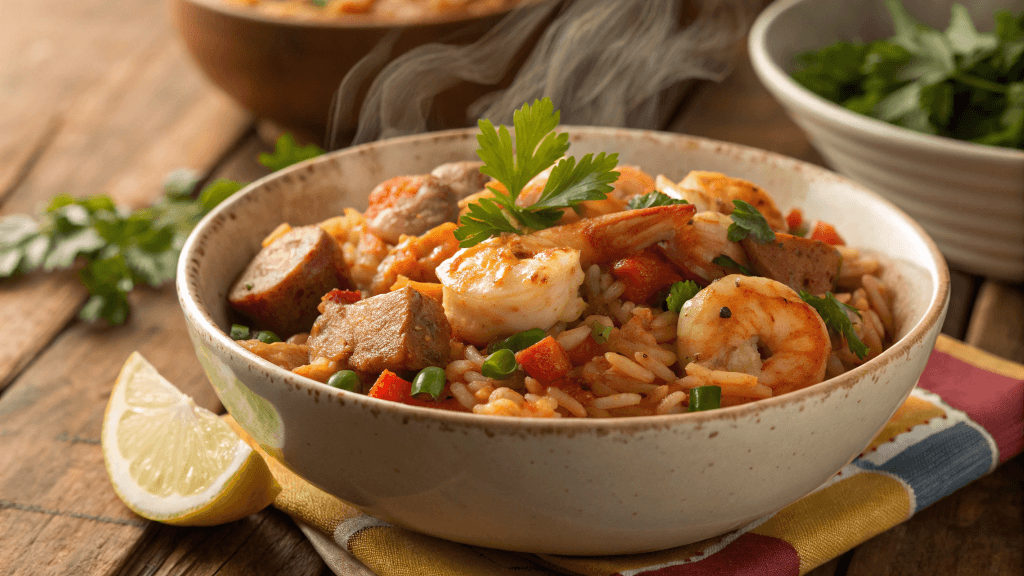
Expert Tips for Perfect Seasoning and Spice Balance
Making the perfect option is an art that needs an understanding of Cajun spices. These spices add magic to your dish. Start with the right seasoning techniques to turn simple ingredients into a feast for your taste buds.
Creating Your Own Cajun Spice Blend
Creating your own cajun spice mix lets you control the flavor. The Maillard reaction is key in making flavors pop, especially when proteins are browned.
- Start with a base of paprika for warmth
- Add garlic and onion powder for depth
- Include dried herbs like thyme and oregano
- Incorporate cayenne pepper for heat (30,000-50,000 Scoville Heat Units)
Heat Level Adjustments
Adjusting the spice level is crucial for a dish that fits your taste. Cayenne pepper adds a lot of heat, but you can adjust it to your liking.
| Heat Level | Cayenne Pepper Amount | Flavor Profile |
|---|---|---|
| Mild | 1/4 teaspoon | Gentle warmth |
| Medium | 1/2 teaspoon | Balanced kick |
| Spicy | 1 teaspoon | Intense heat |
Layering Flavors Throughout Cooking
Slow cooking enhances flavors, with studies showing a 30% improvement. Season in stages, starting with sautéing vegetables and proteins. This builds a rich flavor base.
“The secret to great dish is patience and strategic seasoning.” – Southern Cooking Wisdom
Your goal is to mix cajun spices in a way that makes this classic dish even better.
Serving and Storage Suggestions
Your delicious one-pot meal is ready to enjoy! Jamb-alaya serves 4 to 6 people. It’s perfect for family gatherings or weeknight dinners. Knowing how to serve and store it will enhance your experience.
Serving Recommendations
- Serve hot directly from the pot
- Garnish with fresh scallions (2 thinly sliced)
- Pair with a light salad or crusty bread
- Consider additional hot sauce for spice lovers
Storage Guidelines
After enjoying your meal, store the jamb-alaya carefully. Place it in an airtight container. Make sure it cools completely before refrigeration.
| Storage Method | Duration | Recommended Practices |
|---|---|---|
| Refrigerator Storage | 3-4 days | Use shallow containers for quick cooling |
| Freezer Storage | Up to 3 months | Separate into portion-sized containers |
Reheating Tips
When reheating your jamb-alaya, add a splash of chicken stock. This will restore moisture. Warm it gently on the stovetop or microwave, stirring often to avoid drying.
“A well-stored jamb-alaya is like a culinary time capsule, preserving the vibrant flavors of Louisiana in your refrigerator.” – Cajun Cooking Traditions
By following these tips, your jamb-alaya will stay delicious. Enjoy it fresh or as tasty leftovers.
Conclusion
Your journey into jamb-alaya is more than a recipe. It’s a celebration of Louisiana’s rich food culture. This dish mixes different cultures, turning simple ingredients into a flavorful comfort food that tells a story with every bite.
Making authentic jamb-alaya takes passion and a deep understanding of traditional cooking. You now know how to pick the right protein and use the “Holy Trinity” of onions, celery, and bell peppers. Whether you like Cajun or Creole style, jamb-alaya lets you add your touch.
Jamb-alaya is perfect for gatherings, taking about 1 hour to prepare and serving 5 people. It’s not just food; it’s a way to connect with Louisiana’s culinary traditions. Let your kitchen be a doorway to this amazing American cuisine.
Great cooking is about passion, tradition, and sharing joy. Your jamb-alaya adventure is just starting. Keep exploring, tasting, and most importantly, keep cooking.
FAQ
What exactly is jamba-laya?
What are the main ingredients in traditional jamb-alaya?
Is jamba-laya spicy?
What’s the difference between Cajun and Creole jamb-alaya?
Can I make jamb-alaya with different proteins?
What type of rice works best for jamb0alaya?
How long can I store leftover jamba-laya?
Is jamb-alaya difficult to make at home?
How Was It?
There are no reviews yet. Be the first one to write one.
